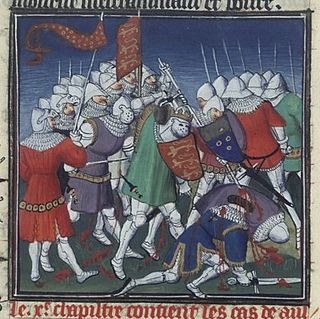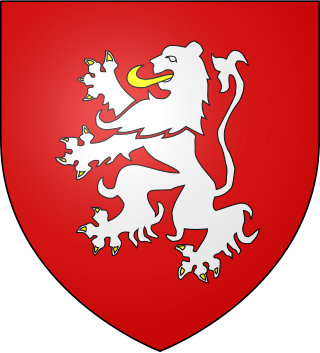Related Research Articles
Thurstan or Turstin of Bayeux was a medieval Archbishop of York, the son of a priest. He served kings William II and Henry I of England before his election to the see of York in 1114. Once elected, his consecration was delayed for five years while he fought attempts by the Archbishop of Canterbury to assert primacy over York. Eventually, he was consecrated by the pope instead and allowed to return to England. While archbishop, he secured two new suffragan bishops for his province. When Henry I died, Thurstan supported Henry's nephew Stephen of Blois as king. Thurstan also defended the northern part of England from invasion by the Scots, taking a leading part in organising the English forces at the Battle of the Standard (1138). Shortly before his death, Thurstan resigned from his see and took the habit of a Cluniac monk.
Ranulf Flambard was a medieval Norman Bishop of Durham and an influential government official of King William Rufus of England. Ranulf was the son of a priest of Bayeux, Normandy, and his nickname Flambard means incendiary or torch-bearer, and may have referred to his personality. He started his career under King William I of England, probably in the compilation of the Domesday Book of 1086, as well as being the keeper of the king's seal. On the death of William I, Ranulf chose to serve the new king of England, William Rufus.

The Battle of Tinchebray took place on 28 September 1106, in Tinchebray, Normandy, between an invading force led by King Henry I of England, and the Norman army of his elder brother Robert Curthose, the Duke of Normandy. Henry's knights won a decisive victory: they captured Robert, and Henry imprisoned him in England and then in Wales until Robert's death in 1134.

Ranulf II, 4th Earl of Chester (1099–1153), was an Anglo-Norman baron who inherited the honour of the palatine county of Chester upon the death of his father Ranulf Meschin, 3rd Earl of Chester. He was descended from the Counts of Bessin in Normandy.

Hugh of Cyfeiliog, 5th Earl of Chester, also written Hugh de Kevilioc, was an Anglo-Norman magnate who was active in England, Wales, Ireland and France during the reign of King Henry II of England.

Ranulf de Blondeville, 6th Earl of Chester and 1st Earl of Lincoln, known in some references as the 4th Earl of Chester, was one of the "old school" of Anglo-Norman barons whose loyalty to the Angevin dynasty was consistent but contingent on the receipt of lucrative favours. He has been described as "almost the last relic of the great feudal aristocracy of the Conquest".

Alan Rufus, alternatively Alanus Rufus (Latin), Alan ar Rouz (Breton), Alain le Roux (French) or Alan the Red, 1st Lord of Richmond, was a Breton nobleman, kinsman and companion of William the Conqueror during the Norman Conquest of England. He was the second son of Eozen Penteur by Orguen Kernev. William the Conqueror granted Alan Rufus a significant English fief, later known as the Honour of Richmond, in about 1071.

Nigel was an Anglo-Norman clergyman and administrator who served as Bishop of Ely from 1133 to 1169. He came from an ecclesiastical family; his uncle Roger of Salisbury was a bishop and government minister for King Henry I, and other relatives also held offices in the English Church and government. Nigel owed his advancement to his uncle, as did Nigel's probable brother Alexander, who like Nigel was advanced to episcopal status. Nigel was educated on the continent before becoming a royal administrator. He served as Treasurer of England under King Henry, before being appointed to the see, or bishopric, of Ely in 1133. His tenure was marked by conflicts with the monks of his cathedral chapter, who believed that Nigel kept income for himself that should properly have gone to them.
Richard de Belmeis was a medieval cleric, administrator and politician. His career culminated in election as Bishop of London in 1152. He was one of the founders of Lilleshall Abbey in Shropshire.
Events from the 1140s in England.
Events from the 1120s in England.
Events from the 1100s in England.

The Abbey of the Holy Trinity at Fécamp, commonly known as Fécamp Abbey, is a Benedictine abbey in Fécamp, Seine-Maritime, Upper Normandy, France.
Ranulf le Meschin, 3rd Earl of Chester (1070–1129) was a Norman magnate based in northern and central England. Originating in Bessin in Normandy, Ranulf made his career in England thanks to his kinship with Hugh d'Avranches - the Earl of Chester, the patronage of kings William II Rufus and Henry I Beauclerc, and his marriage to Lucy, heiress of the Bolingbroke-Spalding estates in Lincolnshire.

The Durham Liber Vitae is a confraternity book produced in north-eastern England in the Middle Ages. It records the names of visitors to the church of the bishopric of Durham, and its predecessor sees at Lindisfarne and Chester-le-Street. In England, it is the oldest book of this type, although it is paralleled by later English confraternity books, most notably the New Minster Liber Vitae.

Eudo Dapifer ;, was a Norman aristocrat who served as a steward under William the Conqueror, William II Rufus, and Henry I.
Urse d'Abetot was a Norman who followed King William I to England, and became Sheriff of Worcestershire and a royal official under him and Kings William II and Henry I. He was a native of Normandy and moved to England shortly after the Norman Conquest of England in 1066, and was appointed sheriff in about 1069. Little is known of his family in Normandy, who were not prominent, but he probably got his name from the village Abetot. Although Urse's lord in Normandy was present at the Battle of Hastings, there is no evidence that Urse took part in the invasion of England in 1066.
Northman was a late 10th-century English earl, with a territorial base in Northumbria north of the River Tees. A figure with this name appears in two different strands of source material. These are, namely, a textual tradition from Durham witnessed by Historia de Sancto Cuthberto and by the Durham Liber Vitae; and the other an appearance in a witness list of a charter of King Æthelred II dated to 994. The latter is Northman's only appearance south of the Humber, and occurred the year after Northumbria was attacked by Vikings.
Richard le Goz, was a Norman nobleman and supporter of William the Conqueror in the Norman conquest of England.

The New Minster Liber Vitae is a confraternity book produced in Winchester, in southern England, in 1031. It records the names of visitors to the New Minster, Winchester and contains other information too, as well as a contemporary image of King Cnut the Great and his second wife Queen Emma of Normandy.
References
- ↑ The name is from the stronghold, Briquessart-en-Livry, of the earls of Chester in the Bessin of Normandy, "where mounds and ditches of their ancient castle remain as a monument of their power" (J. Horace Round and William Page, Family Origins and Other Studies (London:Woburn Books, 1930, 1971) p. 216.
- ↑ Hollister, Henry I, p. 60
- ↑ Hollister, Henry I, pp. 53–4
- ↑ Davis and Whitwell, Regesta Regum, no. 4, and index
- ↑ Davis and Whitwell, Regesta Regum, no. 92
- ↑ Davis and Whitwell, Regesta Regum, no. 130
- ↑ Davis and Whitwell, Regesta Regum, no. 168
- ↑ Davis and Whitwell, Regesta Regum, no. 308
- 1 2 King, "Ranulf (I)"
- ↑ King, "Ranulf (I)"; Rollason & Rollason (eds.), The Durham Liber Vitae, vol. i, p. 159.